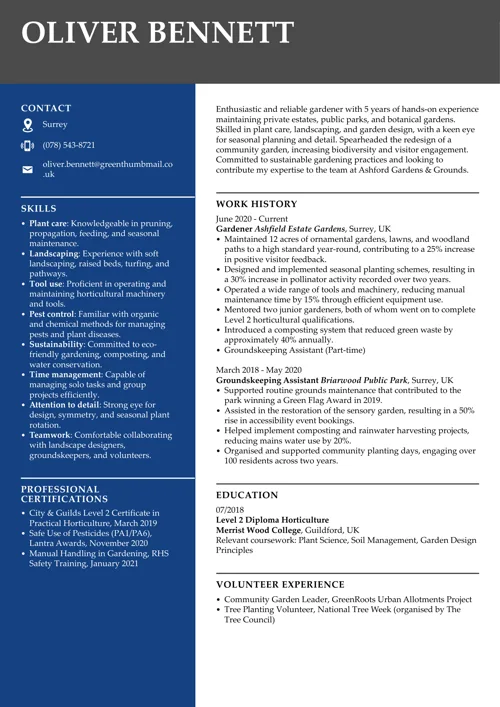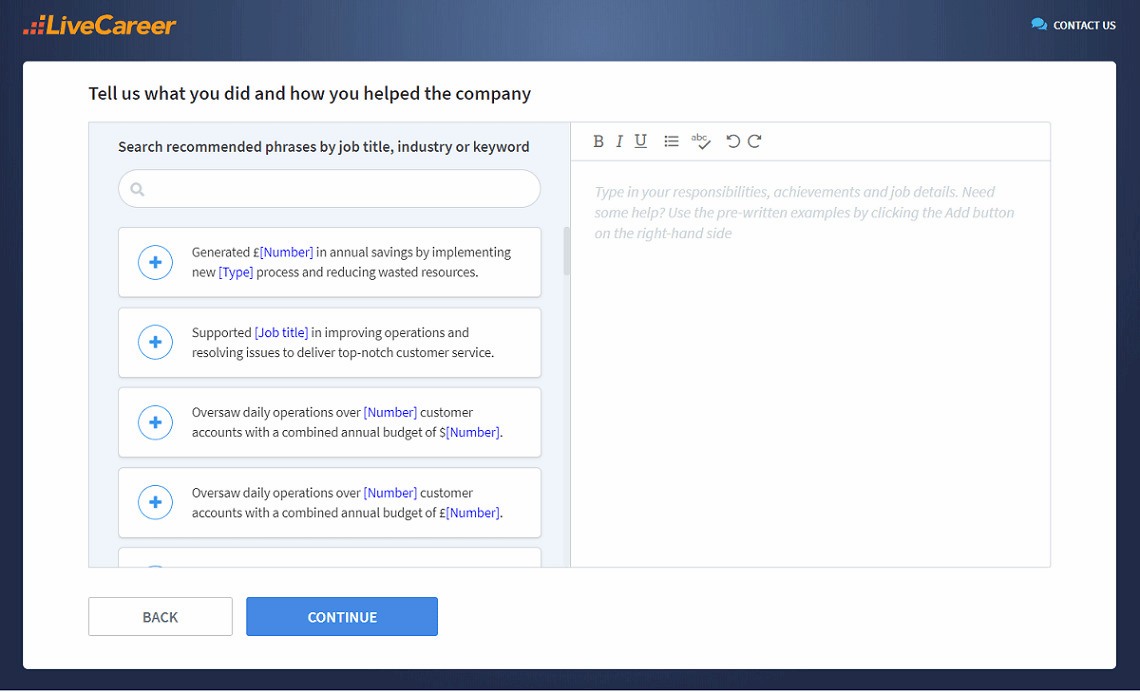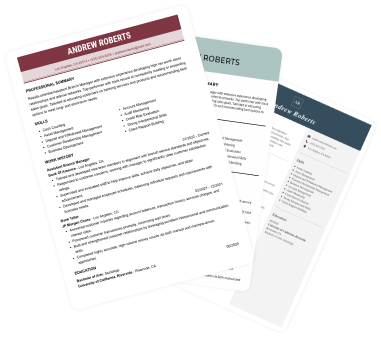Create a professional CV now!
 NO
NO YES
YESLast updated on 29 December, 2025

In 2025, recruitment is no longer just about sifting through CVs or conducting multiple interviews. AI is transforming the hiring process into one that’s faster, smarter, and more efficient than ever before.
Whether you’re a hiring manager looking to optimise the recruitment process or a candidate eager to understand how AI impacts your job search, this guide will walk you through the latest strategies and AI-powered tools. Read on to get everything you need to know about AI recruitment.
Create an effective CV in minutes. Choose a professional CV template and fill in every section of your CV in a flash using ready-made content and expert tips.
Create a professional CV now!
 NO
NO YES
YESWe created the sample on the left using our builder. See other good CV examples like this one.
Looking for more career advice? Check out these helpful guides:
AI recruitment refers to the use of Artificial Intelligence tools to streamline and enhance hiring processes. It includes CV screening, candidate matching, chatbots for communication, and predictive analytics to identify top talent efficiently and reduce bias in recruitment decisions.
AI has begun to play a significant role in optimising recruitment by streamlining hiring processes, mitigating human bias, and improving candidate-job matching through data-driven insights. AI can quickly analyse vast data from job applications, so recruiters can accelerate hiring and concentrate on top talent.
From the candidate’s perspective, AI can be helpful in areas such as chatbots that answer FAQs or schedule interviews. These tools offer real-time and personalised support that keeps candidates informed and actively involved throughout the process. Ultimately, this leads to better hires, stronger retention, and a more efficient recruitment cycle.
Companies continually seek innovative and more efficient ways to attract and hire top talent, particularly in the tech and digital fields, where the demand for skilled professionals continues to grow. In this context, AI recruitment is considered a game-changer in modern HR.
Yet, while AI in recruitment offers significant advantages, it also presents challenges and raises important ethical considerations. Below, I’ve listed the key benefits and downsides of AI in recruitment.
In short, AI brings speed, precision, and more intelligent decision-making to the hiring process. Explore the top reasons why AI is essential for today’s HR teams:
Despite its benefits, AI in recruitment also brings important ethical, technical, and operational concerns. It’s essential to understand these risks to ensure responsible and fair implementation.
AI tools in recruitment can be used throughout the entire hiring process—from finding candidates to onboarding them. Here’s a deeper dive into the most widely used AI recruitment tools and what they do:
These tools automate the initial screening phase by analysing applications to identify candidates who best match job requirements. They use natural language processing (NLP) and machine learning algorithms to compare candidate profiles with specific job descriptions. They mainly look for keywords, education history, experience, and skills, while advanced systems also learn from past hiring decisions to improve their accuracy.
Main benefit: They save recruiters hours by selecting top applicants from hundreds or thousands of candidates.
Concerns: Such tools may overlook qualified candidates with non-traditional backgrounds or those who don’t use exact keywords.
AI chatbots serve as the friendly, always-on front line of candidate engagement in recruitment. Some chatbots can even ask pre-screening questions and score responses, all while gathering valuable data for the recruitment process. Moreover, they can:
Main benefit: Such tools improve response times and keep candidates engaged around the clock.
Concerns: Overuse can make the experience feel impersonal if no human follow-up is available.
These platforms use predictive modelling to assess candidates' potential, such as success in a role, cultural fit, or likelihood to stay with the company. These platforms draw on a wide range of inputs, including personality traits, behavioural assessments, and past performance data.
Main benefit: They enable more informed hiring decisions based on evidence, not just intuition.
Concerns:Predictions are only as good as the data behind them—biased data leads to biased predictions.
AI sourcing tools scan massive data sources like CVs, job boards, LinkedIn, and even GitHub to identify and rank potential candidates, even passive ones who aren't actively job hunting. They use algorithms to match candidate profiles to the company’s hiring needs.
Main benefit: These tools broaden the reach and bring out hidden gems among applicants.
Concerns: Risk of collecting outdated or inaccurate data if tools aren’t updated regularly.
Some AI tools can analyse video interviews, evaluating verbal and non-verbal cues such as tone of voice, facial expressions, and word choice to assess soft skills and personality traits.
Main benefit:These tools add another dimension to candidate evaluation beyond a well-written CV.
Concerns: Such software is controversial and may reinforce biases or misinterpret body language due to cultural differences.
To get the most out of AI while keeping the hiring ethical, fair, and also practical, it’s worth implementing the following practices:
Not all AI tools are created equal. Before selecting a tool, research the vendor’s reputation and case studies. Look into their data sources, algorithms, and results. Check whether the tool meets compliance standards (e.g., EEOC, GDPR). Pick tools that align with your goals, whether it’s speeding up screening, reducing bias, or improving sourcing.
AI tools process sensitive candidate information, so protecting that data is non-negotiable. It is critically important that a company store data on secure, encrypted servers. Additionally, it should limit access to candidate data and ensure that tools comply with data privacy regulations. On top of that, they should be transparent with candidates about what data they’re collecting and how it’s being used.
AI is only effective when appropriately used. Recruiters should understand how the AI works and what it can/can’t do. Know how to interpret AI-generated insights or scores. Be able to intervene when something doesn’t seem right. Training helps recruiters use AI effectively and avoid the risks of relying only on algorithms.
While AI can support decisions, final hiring decisions should always be made by people. Use AI to shortlist, not to auto-reject. Allow recruiters to review and override AI recommendations when necessary. Avoid fully autonomous hiring systems that lack human checks. This ensures fairness, context, and consideration of soft factors, such as emotional intelligence and team dynamics.
Implement regular audits and evaluations of the AI tools. Are they streamlining time-to-hire? Are they helping you meet diversity goals? Do they lead to consistent and fair outcomes? You should continuously test the AI system for bias, possible errors, and unintended consequences. Regular updates and retraining of algorithms may be necessary as hiring patterns change.
AI can cause complications if not managed properly. Keep the process transparent and human-centred. Let candidates know that AI is being used. Provide feedback when possible, especially after declining requests. Ensure that humans are available to answer questions and address doubts. This openness builds trust and reinforces a positive employer image.
While this is a common concern, no, AI is not replacing recruiters. What it is doing, however, is significantly transforming their roles. Rather than removing humans from the hiring equation, AI is automating the most repetitive and time-consuming tasks, freeing up recruiters to focus on more strategic and human-centred work.
What does AI do well:
What humans still do best:
Instead of eliminating jobs, AI is helping HR professionals transition from administrative tasks to more strategic roles, where they can focus on enhancing the candidate experience and talent development. So, AI should be viewed as a partner, not a replacement. The future recruitment processes will be based on collaboration between humans and machines.
If you’re seeking a job, these guides might help you create a strong application:
You don’t have to be a CV writing expert. In the LiveCareer CV builder you’ll find ready-made content for every industry and position, which you can then add with a single click.

I hope this article answered your questions about AI recruitment, whether you’re a recruiter exploring new tools or a job seeker curious about how your application is being evaluated.
Our editorial team has reviewed this article for compliance with Livecareer’s editorial guidelines. It’s to ensure that our expert advice and recommendations are consistent across all our career guides and align with current CV and cover letter writing standards and trends. We’re trusted by over 10 million job seekers, supporting them on their way to finding their dream job. Each article is preceded by research and scrutiny to ensure our content responds to current market trends and demand.
Category: Career Advice
Crafting a job-winning CV is all about showcasing your unique skills and experiences. Start with a strong personal statement that highlights your career goals and achievements.
Try Our CV Builder Now